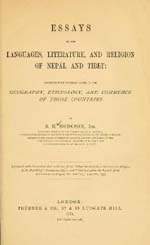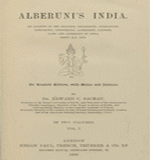
Hodgson’s Essays on the Language, Literature and Religion of Nepal and Tibet (London: Trubner & Company, 57 & 58 Ludgat Hill, 1874)
No other contemporary scholar than Brian Houghton Hodgson (1800 -1894) established himself as a pioneer naturalist and ethnologist in relation to Nepal and the Himalayan studies. His scholarly taste and also his position after 1833 as the British Resident in Kathmandu helped him get involved with and research on the Nepalese people, producing a number of remarkable thematic essays. Hodgson’s Essays on the Language, Literature and Religion of Nepal and Tibet (London: Trubner & Company, 57 & 58 Ludgat Hill, 1874) is an outstanding collection of some of these essays.
The book has two parts. Part 1 is on the language, literature, and religion. Part II is on geography, ethnology, and commerce. The first part starts with the notes on 13 distinct and strongly marked dialects being spoken in Nepal. They are referred to as Khas or Parbatia, the Magar, the Gurung, the Sunuwar, the Kachari, the Haiyu, the Chepang, the Kasunda, the Murmi, the Newari, the Kiranti, the Limbuan, and the Lapchan. Except the Khas dialect, which is Indo-European, Hodgson declares that all the remaining are of Trans-Himalayan stock and closely interlinked.
All these dialects “are all extremely rude, owing to the people who speak them having crossed the snows before learning had drowned upon Tibet, and to the physical features of their new home (huge mountain barriers on every hand) having tended to break up and enfeeble the common speech they brought with them.” Hodgson points out that these dialects are not mutually intelligible to their speakers now. It is only the Newari and Lapchanlanguage that Hodgson points out “can boast a single book, or even a system of letters, original and borrowed.” About Khas language as well, Hodgson notes in his1828 essay that it has “no literature properly so called and very few and trivial books.”
The book covers a surprising range of themes on Nepalese and Tibetan Buddhism. In the sketch of Buddhism, derived from the Bauddha scriptures of Nepal (1828), Hodgson briefly deals with Buddhist literatures available here. There are answers to a set of questions that he posed to a Buddhist scholar in 1823: how and when was the world created? What was the origin of mankind? What is matter and what is spirit? Is matter an independent existence, or is it derived from God? What are the attributes of God? Is the pleasure of God derived from action or repose? Who is Buddha? Is he god or the creator or a prophet or saint; is he born of heaven or of woman?
In the answer to the last question here, the Buddhist scholar who responded to all the questions given by Hodgson states: “Buddha means in Sanskrit, ‘the wise;’ also, ‘that which is known by wisdom;’ and it is one of the names which we give to God, whom we also call Adi-Buddha, because he was before all, and is not erected, but is the creator … Sakya, and the rest of the seven human Buddhas are earth-born or human. These latter, by the worship of Buddha, arrived at the highest eminence, and attained Nirvana Pada (i.e. were absorbed into Adi-Buddha). We therefore call them all Buddhas.”
Hodgson includes in this collection quotations from original Sanskrit authorities in proof and illustration of the proceeding article (1836), European speculation in Buddhism(1834), remarks on M. Remusat’s review of Buddhism (1834), notes on the inscription from Sarnath (1835), notes on Adi-Buddha and of the seven mortal Buddha (1834), notes on the primary language of the Buddhist writings (1837), a disputation respecting caste by a Buddhist (1829), observations on the extreme resemblance that prevails between many of the symbols of Buddhism and Saivism (1828), and notes on the Pravrajya Vrats or initiatory rites of the Buddhists (Illustration).
In Part II, Brian Houghton Hodgson includes his earlier research on the physical geography of the Himalaya (1849), the aborigines of the Himalayan region (1848), origin and classification of the military tribes of Nepal (1833), the Chepang and Kusunda Tribes (1857), cursory notice of Nyakot and of the remarkable tribes inhabiting it (undated), the tribes of northern Tibet and Sifan (1853), the commerce of Nepal [Selections], and the colonization of the Himalaya by Europeans [Selection]. Hodgson describes the Himalayas as generally very well-calculated for the settlement of Europeans, and thus a good region for colonization.
The author is loud and clear in his opinion when he writes of the “duties of the [British] government” to colonialize the Himalayas “for the successful culture of various products suited to the wants of Europeans, for their own consumption or for profitable sale; and in this extra-ordinary gradation of heights, the high and the low are juxtaposed in a manner alike favourable to the labours of the healthful and to the relief of the ailing.” This fitness for Europeans apart, he thinks the colonization of the Himalayas is wise commercially as well.
Hodgson maintains that there is peace in Nepal, and it is paying dividend to the merchants of British India. In the Nepal Valley, he calculates about “fifty-two native and thirty-four Indian merchants engaged in foreign commerce, both with the south and the north, and that the trading capital of the former is considered to be not less than 50,18,000 nor that of the latter less than 23,05,000. A third of such of these merchants as are natives of the plains have come up subsequently to the establishment of the Residency in 1816, since which period, as is thought by the oldest merchants of Kathmandu, the trade has been tripled.”
An 1857 note in the book mentions a costly road that has been constructed recently over the Western Himalayas. However, Hodgson advises that a brisk trade between the Cis- and Trans-Himalayan countries would inevitably seek the route of the central or eastern part of the chain than this road. His finding is that “the Western Tibet is very much the poorest, most rugged, and least populous part of that country. Utsang, Kham, Sifan, and the proximate parts of China furnish all the materials, save shawl-wool, for a trade with us, as well as all the effective demand for our commodities” These findings lead him to conclude that Kathmandu, Darjeeling or Takyeul as the most expedient line of transit of the Himalaya.
As far as Kathmandu is concerned, Hodgson is quick to add that the Newar people have been maintaining an extensive commercial intercourse between the plains of India on the one hand and those of Tibet on the other for many centuries. “Nepal is now subject to a wise and orderly Native Government; that owing to the firm peace and alliance between the Government and the Honourable Company’s, the Indian merchants have full and free access to Nepal.”
The contributions that Brian H. Hodgson made to Nepalese studies were the first significant effort by anybody of his stature, which still has significance today. Some of his opinions are incorrect, and some misleading as well, like his descriptions on the Khas community of Nepal or the story of the Mussulman conquest and bigotry sweeping multitudes of the Brahmans of the plains into the proximate hills. Generally, it is untrue. His colonial mindset may have influenced his analysis at times. It is clear that he also depended on the local pundits, who fed Hodgson with information that provided some immediate benefit to them in the local caste relations.
Hodgson’s mind was many-sided, and his work extended into many fields. Apart from this book, these other materials were also compiled and published in different dates in the name of Miscellaneous Essays relating to Indian Subjects (London: Trubner and Co., 1880), On the Kocch, Bódo and Dhimál tribes (Calcutta: Baptist Mission Press, 1847) and Illustrations of the literature and religion of the Buddhists (Serampore: Self-published. 1841). The 2004 book edited by David Waterhouse on the origins of Himalayan studies is the latest overview, which has been able assess Hodgson’s contributions in the views of several modern scholars. This overview was done long before by W. W. Hunter in Life of Brian Houghton Hodgsonpublished in London by John Murray and Co. in 1896.




